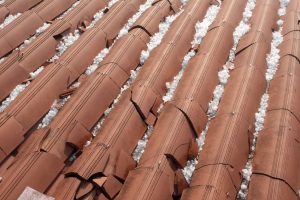 With colder weather on the way, it’s important for American homeowners to know the signs of roofing damage. Your home’s roof is what protects you, your family, and your personal property from the wet and the cold. Any gaps in your asphalt shingles or curling in your slate roofing shingles can cause water damage in your attic and walls.
With colder weather on the way, it’s important for American homeowners to know the signs of roofing damage. Your home’s roof is what protects you, your family, and your personal property from the wet and the cold. Any gaps in your asphalt shingles or curling in your slate roofing shingles can cause water damage in your attic and walls.
However, one type of weather phenomenon many Americans don’t often think about because of its rare appearance is hail. Yet hail can cause a surprising amount of damage on a roof should the impact be strong enough.
Here are some of the most common ways to identify a hail damaged roof and what you can do to ensure your roof’s longevity.
What types of damage to look for
In order to identify a hail damaged roof, you have to first know the types of damage hail can do to your roof shingles. For instance, hail can cause granules in the asphalt of your shingles, cracking, and bruising. Other common signs of damage to be on the lookout for include:
- Missing shingle pieces
- Dents in the shingles
- Circular cracks like a windshield ping
How to identify hail damage
Once you know the kind of damage hail can do to your roof you can begin to search for signs of damage to your shingles. Begin by getting a ladder after a storm to take a closer look at your roof.
Look hard at your shingles. Are there signs of black substrate you can see? Exposed substrate beneath your shingles means the granules of your asphalt shingles have been knocked off by the hail or potentially a branch.
Next, run your hand gently over the surface of your shingles. Class 4 shingles are typically hail-proof, but other types of roofing shingles may exhibit dents you can feel. A dent in your shingle that gives way just a bit when you press your finger against it is a sign of the shingle’s deterioration.
Asphalt shingles have a typical lifespan of 20 to 50 years. However, this depends on the climate and severe weather in the area in which the shingles are installed. If your location is prone to hailstorms, be on the lookout for roofing damage this winter. Without periodic roofing repair, you could end up looking at a necessary roofing replacement.
